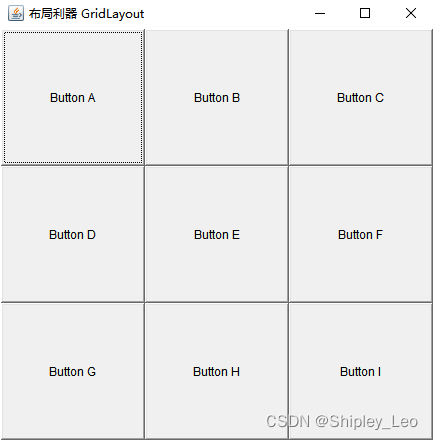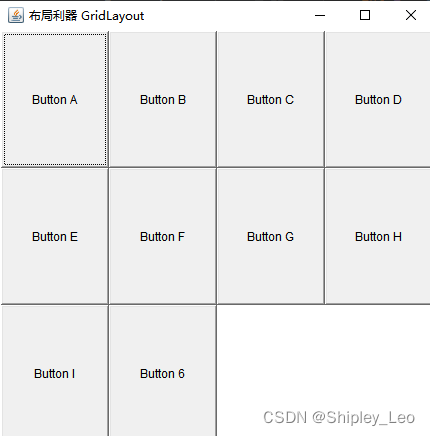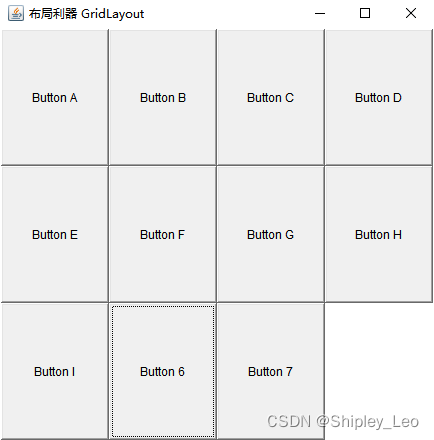【使用 AWT 开发GUI 程序】GridLayout 布局
package com.hk.client.login;
import java.awt.*;
import java.awt.event.ActionEvent;
import java.awt.event.ActionListener;
/**
* 使用 GridLayout 布局
*
* @author: shipleyleo
* @create: 2023-06-04 19:05:21
*/
public class Winfour1 extends Frame implements ActionListener {
int i = 5;
Button b1 = new Button("Button A");
Button b2 = new Button("Button B");
Button b3 = new Button("Button C");
Button b4 = new Button("Button D");
Button b5 = new Button("Button E");
Button b6 = new Button("Button F");
Button b7 = new Button("Button G");
Button b8 = new Button("Button H");
Button b9 = new Button("Button I");
Winfour1() {
// 设置窗口名称
this.setTitle("布局利器 GridLayout");
// 设置布局管理器为3行3列的GridLayout
this.setLayout(new GridLayout(3, 3));
// 将按钮组件放入窗口
this.add(b1);
this.add(b2);
this.add(b3);
this.add(b4);
this.add(b5);
this.add(b6);
this.add(b7);
this.add(b8);
this.add(b9);
// 为每个按钮组件添加监听
b1.addActionListener(this);
b2.addActionListener(this);
b3.addActionListener(this);
b4.addActionListener(this);
b5.addActionListener(this);
b6.addActionListener(this);
b7.addActionListener(this);
b8.addActionListener(this);
b9.addActionListener(this);
// 设置窗口的位置和大小
this.setBounds(100, 100, 450, 450); // setBounds(int x, int y, int width, int height)
// 设置窗口的可见性
this.setVisible(true);
}
/**
* 实现 ActionListener 接口中的 actonPerformed 方法
*/
@Override
public void actionPerformed(ActionEvent e) {
i++;
Button bi = new Button("Button " + i);
this.add(bi);
bi.addActionListener(this);
this.show(true);
}
public static void main(String[] args) {
new Winfour1();
}
}
输出效果:
3行3列的九宫格。

当单击任意按钮,会在原来的按钮 Button I 之后,出现新的按钮 Button 6 。当再次点击任意按钮,则会在上次出现的按钮 Button 6 之后,出现新的按钮 Button 7 。以此类推,如下图所示。


